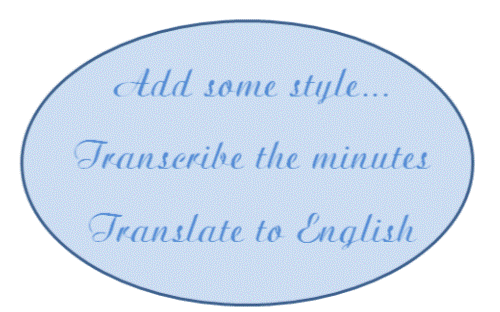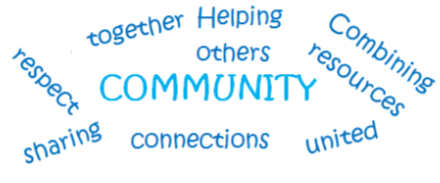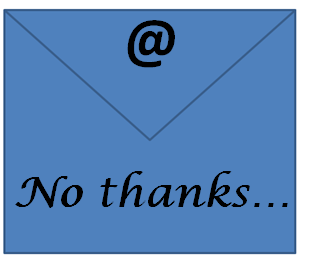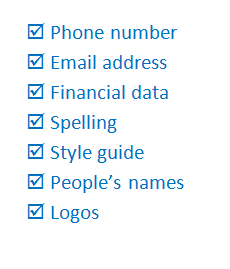I hope you find my writing and business tips and observations useful. My business and blog are dedicated to helping businesses communicate clearly and reach their potential.
Read, subscribe to my newsletter, enjoy!Tash
Translation and transcription styles
As a writer and communications manager, style guides are important.
It was only when I read a book by a freelance translator and transcriber, Kris Emery, that I thought about style guides for other professionals dealing with words.
Getting written documents
If your business need documents translated or meetings transcribed, you are paying someone to give you a written document that will be used in some way.
So obviously you want that document to be prepared in a way that is easy for you to use.
That could include details such as :
- being in your prefered font size so it’s easy for you to read and manage
- spelling certain words in a particular way – it could be ebook vs eBook or it could be how you want your business or product name represented (think of AvSuper, McDonalds and WordPress for instance)
- putting meeting records into columns to separate names from conversations
- location of your logo – you could add it yourself, but why not get the document ready for use?
- having page numbers or preparation dates in a certain place on each page
- things to exclude from a transcription (eg remove um, ah and y’know but leave uhuh)
- page margins or text justification that suits your needs, such as fitting onto a letterhead or space for notes around the text
Preparing a style guide
You have a number of options really…
- rely on the person just to translate/transcribe and change the style yourself
- assume the person will give you a nice format without guidance and just fix the rest – or get lucky and find someone who will ask the questions to give what you want (and probably write a style guide themselves to use when they next work with you – expect to pay for it if you want access to that style guide yourself)
- provide a template and hope the person doesn’t adjust it or any coding behind it
- provide a style guide (or at least a style sheet if your requirements are few) for them to work from
A document-specific style guide will by nature be about details, lots of little details that add up to a polished and useful end result.
It can be pulled together in two hours or so if you have an existing document to work from; faster if you have a style template to work from. That’s not much time compared to adjusting a document every time someone translates or transcribes for you.
What are the first three things you would add to your style guide?
Are they things you consider the most important or just the hardest to do so you prefer someone else gets them right?
You’d think the big guys would get it right…
Is it just me, or do you have more tolerance of a small business making mistakes than a big business?
That is, for mistakes like spelling errors, dead links on their website, out of date information and lack of clarity in a message.
I think if you have the budget for huge campaigns, you have the budget to get a writer or editor to help you avoid stupid mistakes. A sole trader on the other hand often has less money to spend and more hats to wear so mistakes are a little more excusable.
Budget for the details
I was asked by a major entity to complete a survey that they intend to use to produce some data that can impact on the digital media and brands.
It was longer than I expected but more than that, it was very disappointing from a group that is producing such a report.
Having a poor survey through lack of attention to detail reduces their credibility – if they can’t get the questions right, is their analysis going to be any good?
Compared to the time and money they have put into preparing and promoting this survey, and then turning the results into a report, it would have cost little to have had it reviewed by a writer or editor to ensure it would work. It’s like spending a million dollars to build your dream house but not checking the architect remembered to add a front door.
International survey
Some of the issues I came across in this particular survey were:
- I was invited twice (ie via two different .com.au email addresses) to complete this survey. Yet there was a question ‘Please enter your five digit zip code’ – my four digit postcode wasn’t accepted. So are they so ignorant to not realise we don’t all have a US zip code (the error messages actually stated “You must enter a valid US zip code”) or was this survey only meant for US residents?
Tip: if preparing any sort of online form, make it usable for all aspects of your audience – and make it clear at the start if some groups can’t participate - There were too many assumptions within the questions, but I had to answer them anyway so they are getting meaningless results from the survey. For example, “which of the following do you generate money from?” listed about six possible answers – I don’t earn money from any of them but there wasn’t a ‘none of the above’ type answer.
I did get some satisfaction in a couple of those questions if they at least gave an ‘other’ option as I wrote the real answer in that field!
Tip: always have an answer for everyone in a survey – if people can’t answer, they can skew your results with dummy answers and it frustrates them - One question asked ‘what is your key source for finding companies that don’t meet your requirements?’ followed by a series of criteria that you could use to filter out a company and a couple of other points. In other words, it made absolutely no sense and I couldn’t answer it – well I used the ‘other’ field to say it made no sense so I couldn’t choose from their list!
Tip: always do a final read of materials to ensure everything makes sense. Edits along the way can change things so read it in full to be sure – and preferably get fresh eyes to view it, too.

Poor data can’t result in a good report, whichever way you add it
One better written question they included asked where I got inspiration for my blog posts. I could only select one answer, which is limiting as I find inspiration in many places. However, I again used the ‘other’ option and wrote I am inspired by poor communications efforts I see – such as surveys like this with poor questions! You have to find fun where you can, I say!
So not a great survey (and I will struggle to trust their results) but it did inspire a blog post and gave me some amusement using their ‘other’ fields!
Dividing up business tasks
Have you ever looked at how you divide up the work in your business?
Last November, I wrote about looking at tasks rather than entire jobs when deciding on who is needed in a team (or who does what in an existing team).
Look at tasks not roles
As a sole trader it can be overwhelming how many things you have to do.
It can also be overwhelming to think about what you could outsource or employ someone for to gain more control.
I know if I look at what I’d like to get someone else to do (and already do so for some tasks), it seems like a mix of tasks that wouldn’t be easy to give to one role. Or would require a lot of training if I did give it to one person.
However, by taking it one task at a time I was able to see what could be done by others.
So I outsourced the data entry of my accounts to a bookkeeper. Later, I also got her to compile some quarterly stats reports for me.
I got someone else to manage sending out email messages – I write the content but someone else gets it into the email system, manages the email list and sends them for me.
Hiring one person or handing out many tasks at once would obviously free up more time instantly (excluding training time anyway). But if it is too hard to set that up, it won’t happen so a series of small improvements was much more effective for me.
Would you find it easier to look at tasks than jobs, too?
Avoiding fluff keeps the message clear
Whatever message you are trying to convey, the clearer you can make it the easier it will be to understand and remember.
Generally, a shorter, simpler sentence will explain a message better than a long, complex sentence. Or paragraph.
Giving unnecessary options
I recently came across this sentence on a website form: ‘credit card details only needed if posting this form’.
It seems simple enough – we don’t need your credit card details if you send us the form electronically or by courier pigeon. So if you’re not posting the form, save yourself the trouble of filling in half our form is the subtext.
One slight problem though – there was absolutely no way to submit their form except by posting it. The form was just a pdf to print off – there was no online submission nor was there an email address or fax number to be seen on the site.
So what they’re really saying is ‘fill in the credit card details’.
Check if it is needed
I think it’s pretty simple – if the information is meaningless (like credit card details for unavailable options) or useless, delete it.
Sometimes it’s a matter of reading through your words point by point and testing them out.
Sometimes it works better to list what is necessary then go to the text and assess everything not on the list – it may add value so you keep it but otherwise, delete it.
This is just as important when you change something as when you first write it.
In our example above, they may have had email details on the site but removed it to reduce spam and forgot to update the form reference.
When’s the last time you filled in a form on your site or followed your sales process to check it all makes sense and works? Did you read every word to be sure nothing pointless is in there?
being vague builds anticipation – or annoyance?
I’ve travelled on some trains lately which is not something I do very often these days (working from home doesn’t require a lot of train trips!) and read some messages about the new ticketing system.
Now, I called it a new system because it is replacing our old system but it has been in use since the end of 2009! Basically, the myki card is an electronic contact system for public transport throughout Victoria instead of our old metcard system.
Myki has been phased in and many people were still using the metcards earlier this year.
Notices in trains
At each end of train carriage in Melbourne, a ticker system gives messages such as the name of stations as the train approaches.
Recently, that is in October and November 2012, I’ve seen the following message:
myki is replacing metcard in 2012
What do you think of this message?
Build anticipation
Sometimes, not giving the full story is a great way to keep people interested and motivate them to find out more.
Like at the end of season a TV show will have Mary heading into danger while John is arrested on his way to rescue her. If you care about John and Mary, you are drawn to see the next season.
So being vague can have advantages.
I’m not so sure that a vague ‘2012’ is good enough for something like ending a ticket system. Especially as I remember 1 July being advertised as the date metcards stopped…
Commitment or safety?
If I tell you that the blog posts you asked me to write will be ready at 1pm on Monday, you have a clear expectation. And I have made a commitment so will provide the blog posts on time.
If I had told you they’d be ready on Monday afternoon, I have given myself a little more time to get them finished but you still have a commitment to rely on – you know you will have them by Tuesday morning.
Would you be very impressed if I said ‘yes, I’ll write you some blog posts this month and let you know when they’re ready’?
There are times when you can’t be sure of a delivery date so you use less concrete references to save problems and complaints – it gives the business a safety net really.
Maybe I’m just cynical but I think too much safety net behaviour reduces your credibility and people don’t trust you. We have respect for someone brave enough to stand up and say “I will do this by this time” – even if they later adjust the timeframe a little.
So I am not impressed by a message that myki is replacing metcards in 2012.
2012 covers 12 months (10 of which have gone!) and 365 days.
2012 doesn’t give me clarity of when I must change systems. It feels like they have no faith in meeting deadlines so have extended it as much as possible to protect themselves rather than push to meet it.
I think even ‘myki is gradually replacing metcard during 2012’ would have been better if various dates were involved for phasing in myki. Or update the message during the year to be more specific, such as ‘metcard not for sale from July’ and ‘metcard readers now deactivated’.
Make your commitment
What do you think of this public message?
Does something so vague give you enough faith to trust the system? Maybe it seems reasonable to you?
When you are choosing suppliers, how committed do you expect them to be?
Accepting feedback graciously
Anybody who puts effort into writing good content understands the anxiety that can come when someone else reads those words you worked so hard on.
In fiction or business, writers like to think they are using the best words to suit the need yet have to consider their audience’s tastes and preferences, too.
Hearing feedback
Don’t think for a second that highly respected, top-selling authors don’t get their work reviewed and edited by other people – this is not just a business writing issue.
However, what can be different for any business writing is the range of feedback that may be required – one piece of writing may have to satisfy people from legal, marketing, administration, technical and sales teams.
Some people get uptight about feedback as they see it as criticism. Others hear it but rarely act on any of it, while others take note of all the feedback and lose their own feel for the writing.
How do you cope with feedback on your writing? Do you accept and even ask for feedback?
Getting feedback on technical details (for example a client tells me their product is 25 mm thick not 26mm as I wrote) can be easier to take than other feedback as you aren’t expected to be the technical expert.
Feedback about something you are meant to be good at is harder, but usually still isn’t meant personally and needs to be taken professionally.
Improving your writing
Gathering and assessing feedback is a key to getting the best results out of any writing.
Putting together all the different elements can be challenging but melding it together works mush better than having distinct bits of text from each area.
A good piece of business writing often is the collective wisdom of a team with the writer adjusting all those elements to read well. It isn’t about the writer producing perfect prose on their own.
Believing in the team effort and getting the best results for the business makes it much easier to accept feedback.
Once you can accept feedback and tweak your writing to suit, the better your writing will be and the less stressful you’ll find the corporate process.
Little PB Event tips to create big things for you
My first word of advice – if going to what is likely to be a great event with lots to process afterwards, book out the following days so you can process it!
Attending the PB event last week (yes, this time last week I was sitting in a room to hear Shayne Tilley in the second sessions of the day) was great and I came away with lots of ideas, inspiration and information, plus some great new friendships and relationships.
However, it was back to work as usual on Monday morning. Well, I say as usual but I’ve had some urgent client projects come up this week so it has, in fact, been more hectic than usual.
So I haven’t had the time to sit and read through all my notes or listen to the recordings of the sessions I didn’t attend. Or relisten to the great ones I want to get more out of.
Nor share a lot of those tips and insights with others.
From little actions big things happen
Right from the start, Darren set the theme of the weekend to be from little things big things come.
{I have to say that I was often distracted by the song ‘from little things big things grow’ used in an ad promoting a group of industry super funds! Distracting similarity but the message is accurate and valuable in both instances.}
It then followed that all the speakers gave practical information so we could pick up little details and see how to apply them to our own blogs. With everyone repeating that taking things step by step and doing lots of little things you can build a success (however you define success).
Major take home message: make 15 minutes a day to work on something important.
Think about it – 15 minutes a day isn’t that hard to find but adds up to 75 minutes a working week or 60 hours (which is 7.5 working days) a year – with 4 weeks annual leave allowed for 🙂
How many new designs could you create or words could you put to paper or sales calls you could make in 60 hours? That may just be the ‘extra day in the week’ many people wish for.
If you want me to write a post on ways to use that 15 minutes, let me know as a comment or email me – or send me a tweet for that matter!
Provide quality and value for your readers
The event was aimed at bloggers so the message was to give readers quality – but the concept is just as valid for any aspect of your business.
Some points on this:
- Make posts and information products useful and informative
- Find your voice (or brand) and stay with it
- Monitor what your readers like and give them more of that
- If accepting money for a sponsored post or ad, ask ‘what’s in it for my readers?’ You get paid, obviously, but make the post valuable to your readers above all
- add opinions as well as information or share a learning experience so people feel they get an answer (paraphrased quote from Chris Guillebeau)
Make a connection
Various speakers over the conference touched on the importance of engaging and connecting with your audience and with other bloggers.
Here are some of their quotes (written as they spoke so these are close to word-perfect but may be slightly different to their exact words):
Look after and engage your readers – engaged readers will do more for making money than having lots of readers ~ Darren Rowse
Involvement begets commitment ~ James Tuckerman
A focus on building relationships and providing value to people will lead to success ~ Chris Guillebeau
[within your blog have a ] hidden message of ‘you’re not alone’ coming through as everyone needs to feel connection and belonging ~ Chris Guillebeau
Final words
I think Darren had some important words to say in his opening and closing talks.
The theme was little things add to big things, but also to realise everyone starts small so don’t feel inferior to others. Again, based on my notes, he said:
Comparing yourself to other bloggers makes you feel small and is not constructive – focus on good things happening on your own blog. Look at other blogs for inspiration not comparison.
If you have questions or simply want to learn more from the great speakers at PB Event, you could…
- leave a comment below and I’ll do my best to answer you
- grab a virtual ticket to PB Event and hear all the speakers (and see their slides). {Yes, this is an affiliate link so I would get a commission for referring you.}
- use the #pbevent tag in Twitter – there are still a lot of tips being shared
- read blog posts from people who were there – try posts from Belinda, Rita, Helena, Alison and Chantelle to get you started
And with that said, I am off to read more pb event posts myself and do 15 minutes for my subscribers – you can subscribe to get updates of new posts by ticking the box as you leave a comment or fill in the form in the sidebar.
How do you feel as a blogger or small business owner – do you feel small compared to others with more readers or a bigger income? Do you compare yourself to others rather than acknowledging your own progress and successes?
An amazing conference is well worth the effort
Day one is just about over for Problogger 2012 – the formal sessions have finished and we just have a networking even to go before we head for bed (and we’re all going to need a sleep I think!)
For the attendees
Based on conversations I have had, tweets I have read and my own assessment, the event has been fantastic and provided a lot of information and inspiration for a lot of people.
And given the amount of tweets flying around, I think it is inspiring and informing people who aren’t even here!
And it isn’t just about the learning. The speakers have been great, don’t get me wrong, but there is more to a great conference.
You meet people and learn from their stories and experiences.
You feel part of something – and in this case feeling part of a blogging community that can make a difference is empowering.
Listening to other people and other people’s questions can give you a new perspective, too.
Personally, I have a lot of ideas for myself and to share with others from today. I’m excited about implementing them from Monday onwards.
For the organisers
Aside from any financial gain they get, what does a great event do for the organisers?
There must be a lot of satisfaction from helping so many people and having the day flow so nicely.
Obviously, they build their reputation as an authority with credibility.
For the problogger team, I think they also can finish today knowing they have made a difference and are leading us to make a difference, too – and I think that’s something they would be proud of.
So what have we learned today?
The focus has been on monetisation and building communities.
Over the coming weeks I will share ideas and lessons I have learned, and aim to do a summary post early in the week.
For the mean time, the best ways to gain from our experiences today are to search #PBEvent and #PBEvent2 on twitter – hard not to as they were trending terms today apparently!
And grab a virtual ticket to hear the recordings and see the slide shows – you won’t regret the purchase.
And now I am off for a walk to clear my head before the networking.
Why reject people, not ignore them
 Sometimes in business you need to not accept someone. You can choose to actually reject them or you can just ignore them until they effectively go away.
Sometimes in business you need to not accept someone. You can choose to actually reject them or you can just ignore them until they effectively go away.
Whether it’s someone who has applied for a job, sent you a guest blog post or given you a proposal, that person has put some time and energy into contacting you. And quite possibly has some emotional involvement, too.
Of course, I am not counting the obvious spam offers you get – spam doesn’t deserve much in the way of respect and certainly shouldn’t get a response (as tempting as it is often may be!)
Choosing your response
I think those people deserve the respect of being answered. No one likes to hear ‘no thanks’ but it’s better than hearing nothing and waiting for a response.
Do you remember applying for jobs and not getting a response? I hated putting in all that effort and then not being sure they had actually read my application if it wasn’t acknowledged.
Saying no can be done quickly and harshly without any thought for the other person’s feelings. Or with a little more effort you can be respectful and assertive, leaving the other person with their self-respect. Either way, it doesn’t really take that much to give an answer.
You can even have a stock rejection response on file to save time, if you must.
I prefered getting a standard letter than nothing back when I applied for jobs.
Rejecting does have a payoff
Aside from being the humane and decent thing to do, actually rejecting someone’s approach can benefit you as well.
For one thing, you aren’t damaging your own reputation. Offend enough people, or convince enough people are you too lazy to reply, and you may just find fewer people respect you and want to offer you guest posts or their time and expertise.
Sending a nice rejection maintains relationships. Just because you don’t want to use this guest post or don’t think Mary suits your current job position doesn’t mean those people can’t offer you something of value later on. Burning bridges by ignoring people just doesn’t seem like a wise move to me.
What other reasons are there for taking the time to say ‘no thanks’ to people?
Have you had good things come out of a ‘no thanks’ response?








Recent Comments